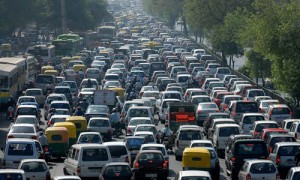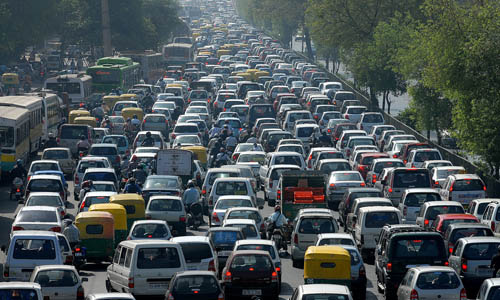News Point: One day of rain and the life goes haywire in the glorified millennium city, Gurgaon. And there are plans of TOD to add more pressure on the over-burdened infrastructure.
 The rains wrecking havoc on the infrastructure of Gurgaon has yet again ignited the debate as to whether Transit Oriented Development (TOD) could be a success story in a city that is over populated amidst infrastructure crumbling.
The rains wrecking havoc on the infrastructure of Gurgaon has yet again ignited the debate as to whether Transit Oriented Development (TOD) could be a success story in a city that is over populated amidst infrastructure crumbling.
The government has already given nod last month to Transit Oriented Development in Gurgaon and the built environment of the real estate in the millennium city has welcomed the move. However, beyond the issue of expected fall in land and home prices, the core issue today is whether Gurgaon can cope up with added load on land and infrastructure.
News bytes
- Haryana Government has given nod to Transit Oriented Development in Gurgaon
- The areas up to 500 meter from the metro routes will fall under ‘intense TOD zone’, and will get an FAR of 3.5, from the existing FAR of 1.75
- Areas under ‘Transition TOD Zone, between 500 meter and 800 meter, will get an FAR of 2.5
- TOD might create urban mess in already infra deficient Gurgaon
On paper the policy of TOD may be in sync with the growing demand in the city. After all, the areas up to 500 meter from the metro routes will fall under ‘intense TOD zone’, and will get an FAR of 3.5, from the existing FAR of 1.75, while areas under ‘transition TOD zone, between 500 meter and 800 meter, will get an FAR of 2.5.
But with increasing urbanization and migration of rural workforce in search of jobs, the millennium city is today suffering from a soda bottle syndrome. There is so much of rural push that this over-populated urban pocket is unable to pull or cope up, leading to increasing pressure on the infrastructure and the transportation.
The urban planning analysts are hence debating as to whether TOD is the way forward for Gurgaon. A Transit Oriented Development is a mixed-use residential and commercial area that is compact with higher density and is designed to maximize access to public transport. It encourages transit ridership and feasibility of walk to work.
A TOD neighborhood typically has a center with a transit station or public transport stop. TODs generally are located within a radius of one-quarter to one-half mile (400 to 800 m) from a transit stop, as this is considered to be an appropriate scale for pedestrians.
Many of the global cities that emerged after the World War II were conceptualized with TOD in mind. It is still quite debatable subject internationally. The Indian story thus far has been more about urban sprawling than TOD. The existing load on the infrastructure and resources are already so high that many urban planners resisted the temptations to go for Transit Oriented Development.
Today, the question that is being debated in Gurgaon is whether TOD is the only way to create stronger pools of affordable housing by making transport facilities more accessible, thereby making longer distances easier to commute. Will the move be detrimental for a city that is still struggling to create decent livability index?
Ashok Sinha, an architect and urban planner disagrees with TOD in Gurgaon when he questions whether TOD is the way forward in over-supplied and over-populated areas. According to him, areas closer to metro like Golf Course Road are already so cramped that any further addition of FAR will deprive the residents with the breathable spaces.
“One day of rains and we all know the standing of Gurgaon in terms of coping with basic infrastructure due to absence of holistic planning. The TOD that will add more pressure on the already crumbling infrastructure will make living in Gurgaon a capital punishment. This defies the logic of urban planning in a city where the haphazard growth has already taking its toll,” says Sinha.
The developers have by and large welcomes TOD in Gurgaon. They maintain the move will bring the property prices down. A section of developers nevertheless have their apprehensions.
Nikhil Hawelia, Managing Director of Hawelia Group believes the debate of saturated developments closer to CBDs versus the urban sprawling is not new. According to him, the global experience suggests that where there is scarcity of land, one should opt for TOD kind of development. This is not the case with Gurgaon where the availability of land suggests more horizontal growth with adequate infrastructure.
“With the kind of sprawling growth potential that the region has I don’t see a reason why we should put more pressure on the crumbling infrastructure of Gurgaon. Instead of TOD, I feel the focus should be on public transport and better connectivity that could make locations beyond Gurgaon accessible for both affordable housing as well as make travelling easier for the workforce,” says Hawelia.
Internationally, having an apartment in New Jersey and commuting to Manhattan or living in Lewisham and working in Canary Wharf has also been possible because of fast, reliable and superbly comfortable public transport. So, it is a two-way street where quality of commute also determines the success of TODs in metropolitan hubs.
In Gurgaon the irony is that both the public transport as well as the load on existing infrastructure do not seem to encourage the Transit Oriented Development.
Moreover, the global cities that have succeeded with the TODs have a young, digitally connected and aspiring work force which prefers public transport as one can do more with the commute time. For example, in Hong Kong over 90 per cent of commuters use public transport (including MRT) everyday, which is the highest in the world. Singapore’s success is more on being cost effective, the benefit of which helps to balance out costs in other areas, including real estate.
TOD should not be applied only with limited objective of reducing the property prices. The contrarian view about TOD in Gurgaon is that instead of reducing the price of land and apartments, the TOD will only make the areas closer to CBDs costlier. This naturally would defeat the very purpose of TOD. The quality of life and livability index will definitely suffer in the process due to infrastructure challenges.
Analysts hence suggest that instead of TOD kind of development if the government is able to focus on providing road infrastructure coupled with public transport in areas where roads are not currently in existence this can potentially increase the land stock substantially thereby bringing in low cost land which can be used for affordable housing.
By: Ravi Sinha





